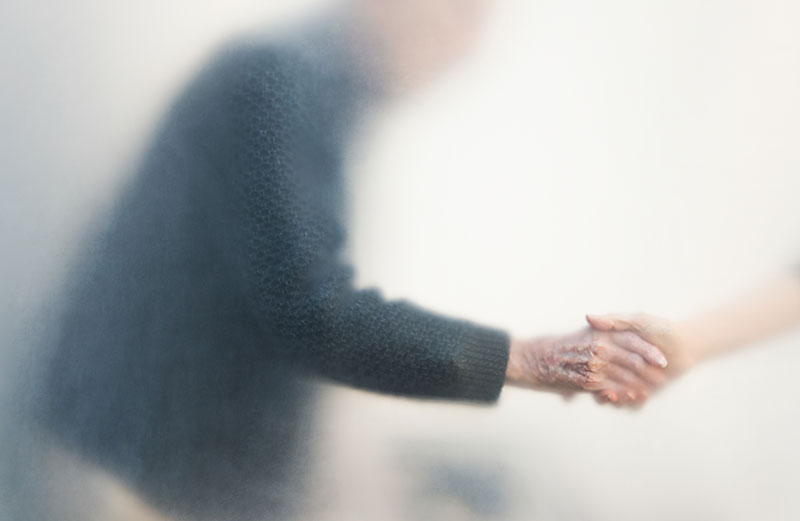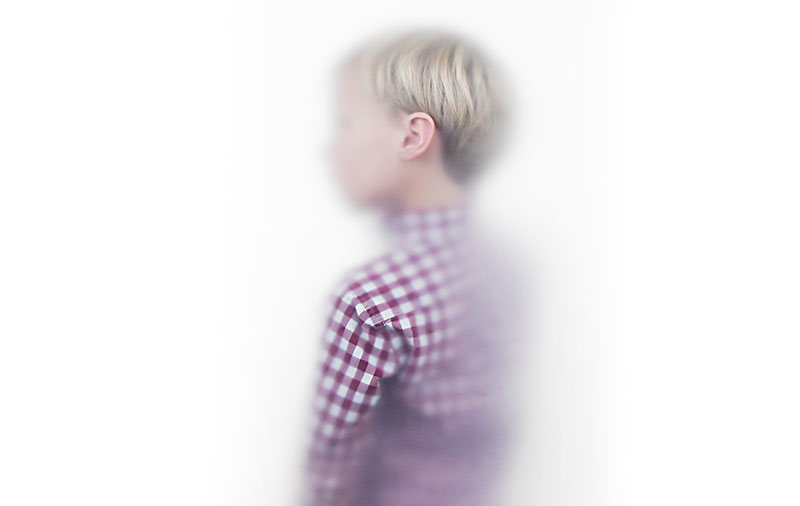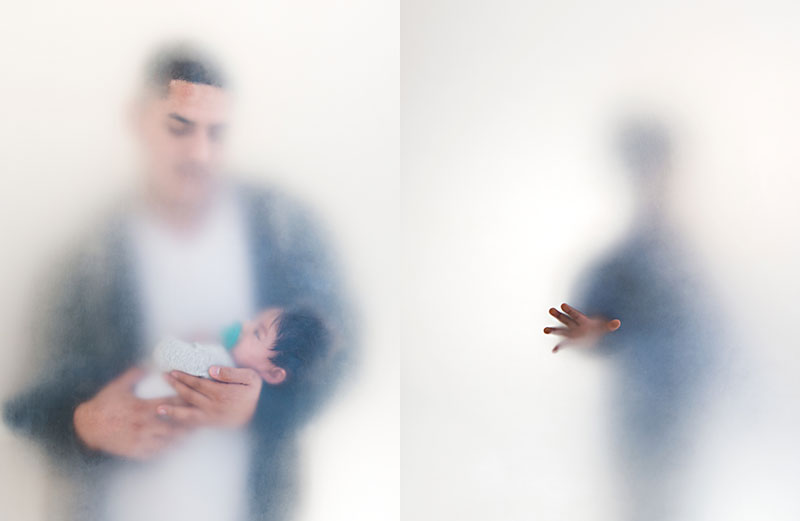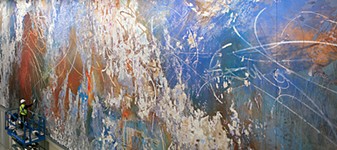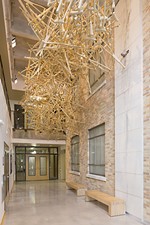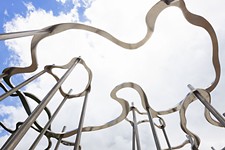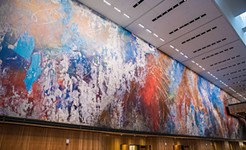UT's Public Arts Program Debuts an Ambitious New Project
Landmarks presents Ann Hamilton’s O N E E V E R Y O N E at the Dell Medical School
By Robert Faires, Fri., Jan. 27, 2017
The girl in the photograph looks to be enveloped in fog – there are no edges to the sandy hair crowning her head or to her cherubic cheeks or to the floral-patterned PJs covering her slight frame, just blurs of color caught in the obscuring embrace of a great grayish void. Curiously, though, there are two areas where the haziness gives way to sharp resolution: part of her face and her hands, held gingerly across her midsection. In the former are clearly defined the playful curve of the tip of her nose, strands of hair swooping down her forehead, and the thick lashes of her right eye, which is trained squarely on us. In the latter are the slightly bent fingers of her left hand, each so distinct that wrinkles on the knuckles may be seen, and just below them, the similarly bent digits of the right, only with the index finger capped by a white medical monitor, from which a cord loops to and coils around her right wrist. The clarity of these areas gives the impression of this girl having found the boundary of this fog and leaned into it, pressing these parts of herself to it that we might see them clearly.
Which is just what she did. Except that the fog was actually a kind of translucent curtain that makes anything behind it look fuzzy unless it's in direct contact with the curtain's surface. So when this girl, Zoe, was having her portrait made, she was behind the curtain, and visual artist Ann Hamilton was on the opposite side of it, giving Zoe the same sorts of instructions that Hamilton has given to hundreds of other people she's photographed like this in the series of public art projects that she calls O N E E V E R Y O N E: "Step forward. Turn. Look this way. Let your hand touch the screen. Let your forehead touch," and so on. In Zoe's image, her hands and face are what come into focus, but the body part in contact with the curtain might just as easily have been a shoulder, an ear, the back of a head .... Hamilton positions her subjects in O N E E V E R Y O N E every which way, not to seek out the ideal representation of face and figure as in a traditional portrait, but to discover something distinctive, something telling, in a part of the person, something revealed in a touch.
Touch, you see, is central to this latest iteration of O N E E V E R Y O N E, one that Hamilton has developed for Austin and, specifically, the Dell Medical School at the University of Texas. Just as touch is integral to any health care experience – from the nurse's hand against your forehead feeling for a fever to the surgeon's handling of a transplanted heart – touch is key to the experience of these portraits: It's where the images find clarity. Hamilton, a MacArthur Fellow and National Medal of Arts recipient, came to understand how a depiction of touch in art could reflect the importance of touch in medicine when she was commissioned by Landmarks, UT's exemplary public art program, to create a project for the new medical school complex.
"In the context of health care and doctors," says Hamilton, "touch is recognition, right? You sit with a doctor or nurse or whoever is providing care, and touch is the recognition that acknowledges you. It's face to face, and there's nothing that replaces that and the value of that."
Hamilton has spent months exploring the value of that and the result, debuting this week at the Dell Medical School and the UT Visual Arts Center, is Landmarks' largest and most ambitious project to date, as well as its most personal. The numbers tell the first part of the tale: Zoe's portrait is one of 21,000 images that Hamilton made of 500 people at 12 sites around town. Seventy-one portraits have been treated with a touchable enamel and will be housed permanently in different buildings of the medical school. But portraits of all 500 subjects have been gathered into a 900-page book, 10,000 copies of which will be published and circulated for free in the medical school and across campus. Moreover, a newspaper has been produced with essays from professionals in various fields writing about ideas behind the project, like the meaning of health care and the importance of touch, and all 21,000 images will be placed on the project website and available for anyone to download. They will also form a library that can be drawn from as the project grows in other buildings around the medical school. Landmarks has certainly brought UT monumental projects before – think Nancy Rubins' Monochrome for Austin, with its spectacular stack of aluminum canoes, or Ben Rubin's And That's the Way It Is, with its projected newsfeed from both the Sixties and today scrolling across the Communications building facade at night – but O N E E V E R Y O N E, with its hundreds of participants and thousands of printed books, is on a scale all its own.
Several of Hamilton's prior projects have been expansive like this, but that isn't why Landmarks Director Andrée Bober had sought to work with Hamilton for years. "I wanted to work with Ann," she says, "because she's an artist who produces excellent work of the highest quality, and work that I and many other people respond to deeply." That work takes many forms – radically different forms, from huge architectural installations to a meditation boat, from sculptures made of nontraditional materials to photos taken with a tiny camera held in her mouth – so Bober didn't know what form Hamilton's commission for Landmarks would take. ("At the beginning," she says, "I thought maybe it would be a landscaping element near Waller Creek.") All she was sure of, based on Hamilton's body of work and how the artist "relates to each individual condition in which she's working – responding to the history, responding to the place," was that it would be uniquely about this community.
Bober's first attempts at lining up a project with Hamilton didn't pan out, but when the medical school commission came along, "everything was just aligned," she says. The dean of the medical school, Clay Johnson, was enthusiastic about the project, and Hamilton, in turn, was excited by the ethic of the medical school – its goal of developing new models for health care, particularly for the interaction of patients and health care professionals. Hamilton also felt that Austin's vote to increase its property taxes to fund the school was a statement by the community that wellness matters. It's an acknowledgment, says the artist, that "all of us will at some point arrive or leave or interact with medical care. Everybody's in this club, right?"
"That's why I love the O N E E V E R Y O N E title," adds Bober, "because it is very inclusive in that way." As the project took shape, and Hamilton and Bober began to seek out 500 individuals for portraits, people would ask, "Do you have to be a patient to participate, or do you have to work at the hospital?" And, says Bober, "it evolved into us saying, 'Well, if you've ever provided care or received care, you're in.'"
In making the images, Hamilton was mindful of parallels in the relationship of a patient and health care provider and that of the portrait subject and photographer. Both patient and subject are exposing a part of themselves that the rest of the world doesn't get to see, and just as the patient must extend trust to the caregiver looking after their body, the subject has to extend trust to the person with the camera, to allow himself "to be seen in a vulnerable way," says Hamilton. "You are vulnerable in front of a camera even in the age of selfies, right?"
The medium by which that trust is often established is touch, and what's curious about that, notes Hamilton, is that it's literally invisible: "When you're touched, there's no light there. When you make contact with something, that actual contact is not a visible thing." So the artist's use of the curtain in which only the things in contact with it are in focus "makes touch visible," she says. "It's about trying to capture a little about what that is and what that feels like."
To someone observing Hamilton's efforts to capture that feeling for O N E E V E R Y O N E, the experience may look as common as an ER visit where a curtain is drawn for privacy, with the artist giving instructions like ones we're accustomed to hearing from a nurse or doctor: Take a deep breath. Stick out your tongue. Turn your head and cough.
But for the person behind the curtain, the experience feels distinctly less common – like having a doctor examine you without coming into the room. According to Bober, who has been behind the curtain numerous times, "You can't see, so you're just listening [for Hamilton's voice] and waiting for that instruction, that guidance, and you hope you're doing it right."
That isolation has a purpose, though, says Bober. "When you can't see and you're relying on words in your ear to give you guidance about what you're supposed to do, you naturally go into your head. You're not thinking about the camera." Then, Hamilton adds, "your guard is down, so you're not so presenting to the camera." The results, says Bober, "are these unusual portraits ... very intimate" with a "vulnerability in them."
The focused act of listening and responding to Hamilton forms a bond between subject and artist. "There's a bit of energy that's exchanged with each person," she says. "I don't know how else to describe it."
"It's an unusually intimate exchange between two people who don't know each other," offers Bober, "and it happens very quickly. They slip into that space of really relying on your voice. I can't tell you how many people, after stepping out from behind the curtain, just embraced you."
"There's something about this mutual 'doing this thing together,'" says Hamilton as she reflects on it. "What are those opportunities in our culture now to make any contact with people that we don't really know? So that means so much."
Of course, developing those connections with 500 people made the task of paring down those 21,000 images for the book and panels "very hard." Deciding that everyone who participated in the project would be represented helped, plus she began to think about the images as not portraiture but something "more gestural, like 'Oh, is there something about the way the elbow hits?'"
Some of Hamilton's image choices were dictated by placement in the buildings. "How will this work with this architecture at this scale? That was all predetermined, so how can I work with that? So much of it was formal in the end. This needs to have movement. The color of the clothes. Wanting to represent ages and represent the diversity of the community. Sometimes it was like, 'This is an incredible image, but they're wearing bright red clothing, and it's not going to work in here.' It was a long process. For me, the decision was to some degree, do I have a felt response to this image?
"I've gone through I can't tell you how many times every image of every person, and what's interesting is that every time I see them differently. One time you're editing them with one eye, another time you're editing them with another eye. There were times when I would go through all the images and pick only things where there was no face. Then I was like, 'No, we really have to have people's faces in here.' It's a real back-and-forth. And I'm sure if we have a chance later to produce more permanent ones, a different eye will be selecting them."
The more one learns about O N E E V E R Y O N E, the more it seems a natural extension of what Landmarks has always done: utilize art to spark and engage public spaces on UT's campus. Bober doesn't disagree: "You can look at this as a continuation of exactly what we set out to do: to provide great works of art that are of a really high quality, that are accessible to everyone, that are free. It's like another step forward – another giant step forward."
But the founder of this program is also conscious of the changes that O N E E V E R Y O N E represents. "If you had asked to do a book and a newspaper five, 10 years ago, I would have probably said, 'I don't think that's possible.' It probably wouldn't have been possible. And part of the reason why it becomes possible is because it's always easier to get people excited about something when it's tangible. When it's just an idea, it's very difficult to get people to understand why they should be enthusiastic. Now we've had the opportunity to bring these incredible works of art by leading artists to our campus, so instead of you trying to convince somebody to get behind an idea, they're having their own relationship with works of art and realizing that it creates a sense of community, that their own engagement is something that they value. Once that becomes part of our shared experience, it opens the possibility of a project like this happening. Prior to Landmarks, that had never been part of the university culture, so it was more difficult to imagine what that would be or how that would work. O N E E V E R Y O N E is pretty breakthrough because it demonstrates how far we've come. When we began this program, the most common question we would be asked when we'd begin the conversation with a dean or team that needed a new building on campus was 'Why do I have to spend money on this?' Now, the most common question we get is, 'What is my art gonna be?'"
O N E E V E R Y O N E Special Events
O N E E V E R Y O N E: A Conversation with Ann Hamilton
Landmarks and the Humanities Institute host a talk with Ann Hamilton led by Pauline Strong, and readings by Matthew Goulish, Natalie Shapero, and Brian Rotman. Thu., Jan. 26, 7-8:30pm, LBJ Auditorium.
Landmarks Q&A with Ann Hamilton / Opening of "O N E E V E R Y O N E"
Landmarks and the Visual Arts Center host a discussion between Ann Hamilton and critic Nancy Princenthal. An exhibit of panels from O N E E V E R Y O N E will be on display in the VAC Jan. 27-Feb. 27. The event is free, RSVP requested: www.landmarksrsvp.org. Fri., Jan. 27, 5:30pm, ART Bldg. Auditorium, 23rd & San Jacinto.
O N E E V E R Y O N E Booksigning
Ann Hamilton will sign free copies of the 900-page book designed for the project. Sat., Jan. 28, 2-5pm, Dell Medical School, Health Learning Bldg., 1501 Red River.
More Landmarks
The full collection of Landmarks public art works currently consists of 38 works spread across the UT campus. Twenty-eight are sculptures on loan from the Metropolitan Museum of Modern Art in New York. Here's a list of additional works that were commissioned and created by Landmarks before O N E E V E R Y O N E. For more information, visit www.landmarks.utexas.edu.
Spiral of the Galaxy by Marc Quinn
Health Learning Bldg. courtyard, 1501 Red River
Giant gleaming bronze seashell
The Color Inside by James Turrell
Student Activity Center rooftop
Skyspace structure for viewing sky colors
(Forever Free) Ideas, Languages, and Conversations by Michael Ray Charles
Gordon-White Bldg. atrium, Whitis & 24th
Installation of suspended wooden crutches in star clusters
And That's the Way It Is by Ben Rubin
Walter Cronkite Plaza, Whitis & Dean Keeton
Text from newsfeeds of the Sixties and today scroll across the Communications building facade
Monochrome for Austin by Nancy Rubins
Speedway & 24th
Giant cluster of aluminum canoes
A Mathematical Theory of Communication by Casey Reas
North building, Bill & Melinda Gates Computer Science Complex & Dell Computer Science Hall
Wall-sized abstracted image of TV signals
Wall Drawing #520 by Sol LeWitt
North building, Bill & Melinda Gates Computer Science Complex & Dell Computer Science Hall
Colored cubes painted on a wall
Circle With Towers by Sol LeWitt
Speedway entrance, Bill & Melinda Gates Computer Science Complex & Dell Computer Science Hall
Concrete blocks set up in a geometric structure








